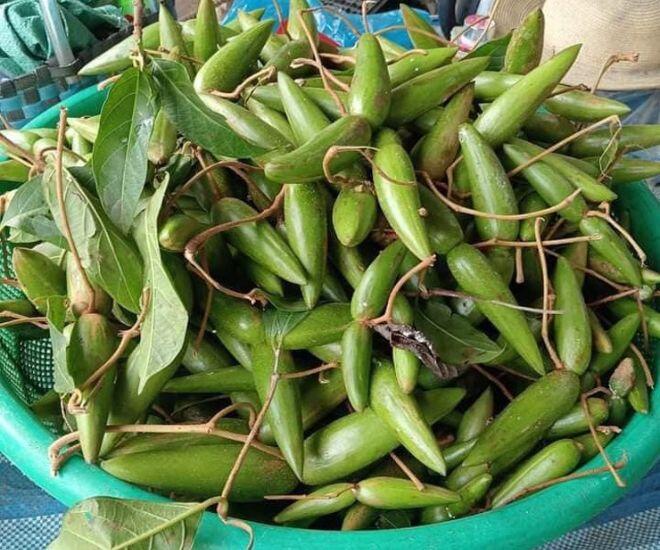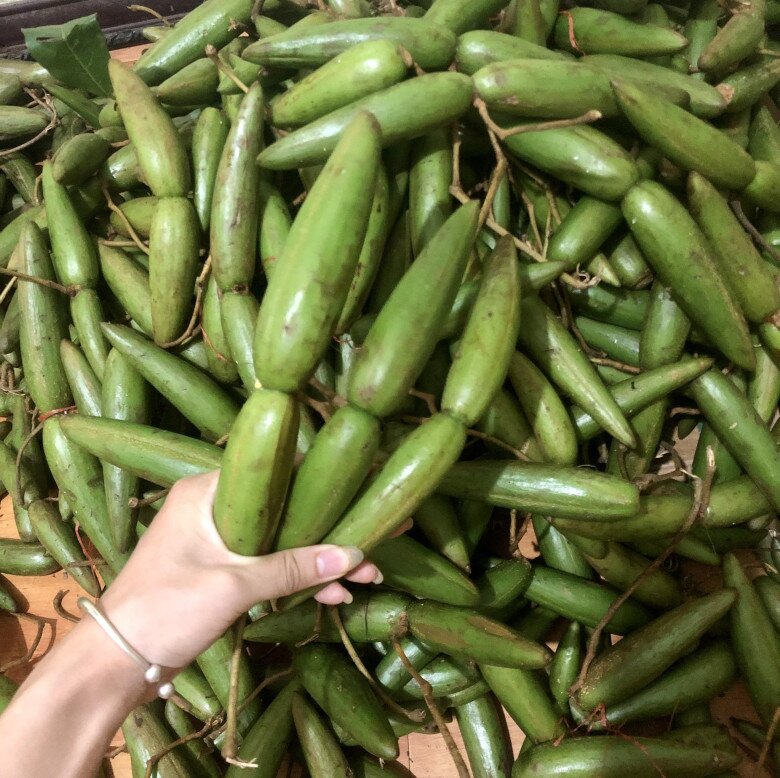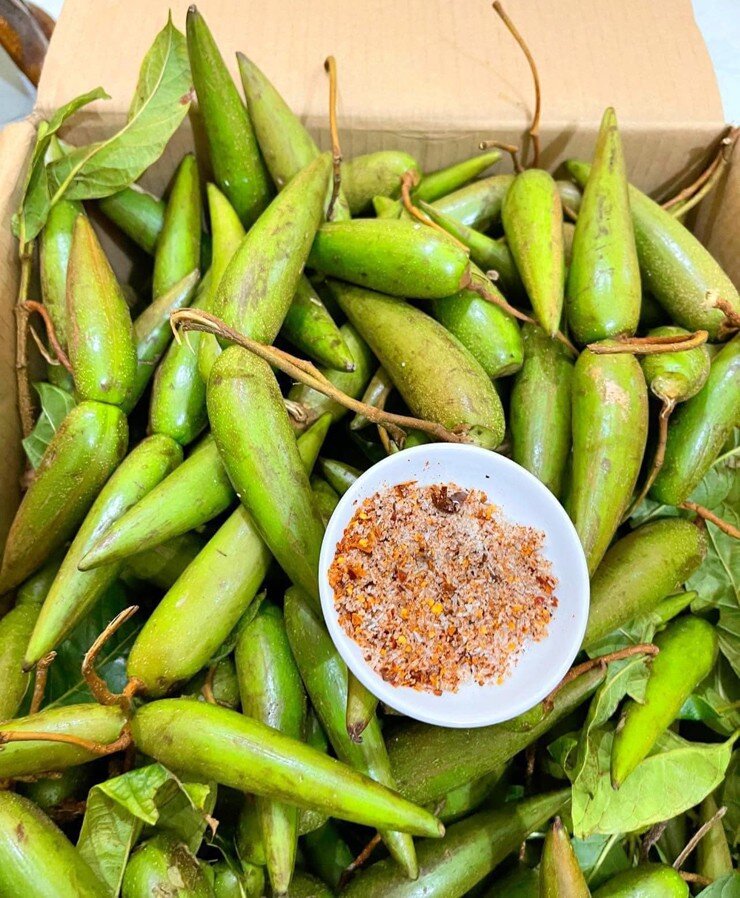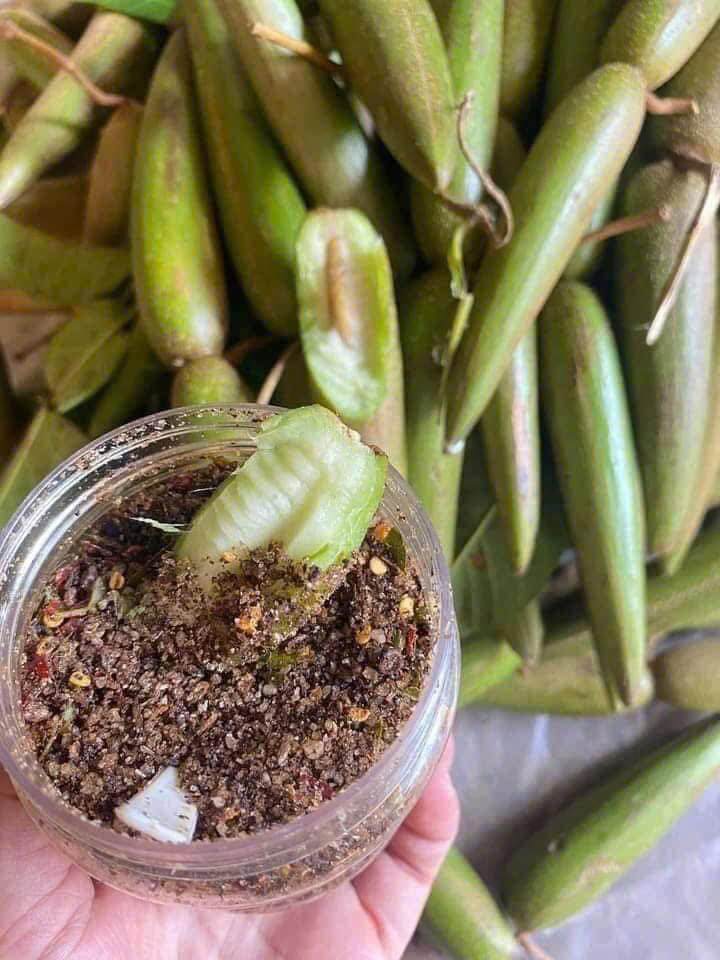
According to the book “Medicinal Plants and Animals in Vietnam,” the buffalo horn fruit (scientific name: Marsdenia glabra) belongs to the Asclepiadaceae family and is also known as goat horn. Its name derives from its distinctive shape: a pod with two pointed ends, connected at the base and flaring outward, resembling a pair of buffalo horns. The fruit is medium-sized, measuring 10–15 cm in length, with a hard, green outer shell. When split open, it reveals numerous small, pointed seeds enveloped in a silky white down.
In Vietnam, the buffalo horn plant is widespread across all three regions, but it is most common in the northern mountainous provinces. It typically grows wild in bushes and along the edges of sparse forests, abundant in areas like Dien Bien, Lao Cai, Son La, Phu Tho, and Tuyen Quang. Historically, this fruit was plentiful in the forests but largely overlooked. For local residents, especially children in the highlands, it was merely a playful snack or a toy due to its unique shape. Its economic value was negligible, and harvesting was limited to personal use.

However, in recent years, a notable shift has occurred. Thanks to social media and various communication channels, the buffalo horn fruit has gained widespread recognition. Its unique tangy flavor, crisp texture, and refreshing sourness have sparked a craze, transforming this wild fruit into a sought-after “clean specialty” from the mountains. Residents in the highlands have begun harvesting it more systematically, not just for consumption but also for distribution to neighboring provinces. Growing demand from urban markets has opened new opportunities, providing highland communities with a stable additional income source.
To fully enjoy buffalo horn fruit safely, specific preparation steps are essential. The fruit’s outer shell contains a white latex that imparts a bitter, tart taste and can cause throat irritation. Therefore, before consumption, the fruit is thoroughly washed to remove the latex, and the outer skin is carefully peeled. The most authentic and popular dish made from buffalo horn fruit is a salad. The peeled fruit is sliced thinly, mixed with crisp jicama and fragrant cilantro, and served with “chẳm chéo,” a traditional Northwest Vietnamese dipping sauce. This combination not only balances the fruit’s sourness but also creates a harmonious blend of flavors that tantalizes the senses.

Beyond the traditional preparation, buffalo horn fruit has been creatively adapted into various snacks catering to younger tastes. Young, peeled fruit can be dipped in chili salt or prepared more elaborately by tossing it with chili salt, pickling it in a sweet and sour brine, or pairing it with Thai sauce. Each method offers a distinct experience, ranging from spicy tanginess to a mild sweetness with a hint of sourness, making it irresistibly appealing.
Interestingly, in some areas, locals use buffalo horn fruit not just as a snack but also as a seasoning. Its natural mild sourness is utilized in soups, particularly fish soup, to eliminate fishy odors and balance flavors, resulting in a refreshing and savory dish. This innovative use of the fruit highlights the ingenuity and deep understanding of indigenous communities in maximizing the potential of forest products.

The rise in popularity of buffalo horn fruit has also led to price fluctuations. In producing regions, prices range from 30,000 to 50,000 VND/kg, depending on the season and supply. However, when transported to major cities like Hanoi or Ho Chi Minh City, prices often double or triple, reaching 90,000 to 100,000 VND/kg. Despite the higher cost, many consumers are eager to pay to experience this novel flavor.
The buffalo horn fruit’s journey from obscurity to fame exemplifies how seemingly insignificant forest products can become coveted specialties. It’s not just a story about a wild fruit but also a narrative of uncovering, promoting, and bringing hidden values closer to the public. From a highland children’s snack, the buffalo horn fruit has become a culinary emblem, a cultural bridge that brings the distinctive flavors of the Northwest mountains to every corner of the country.






























